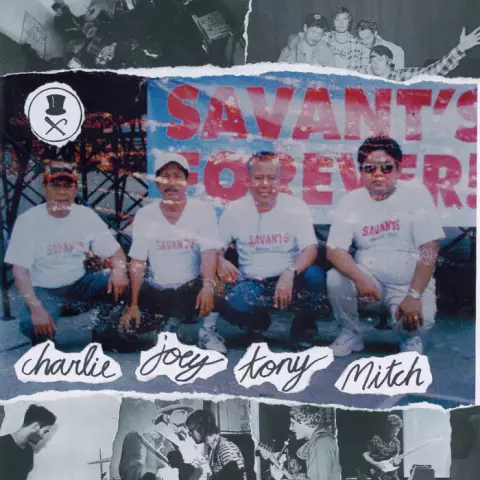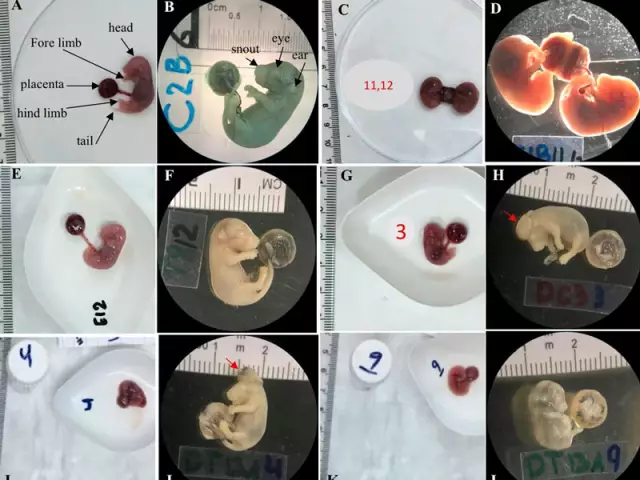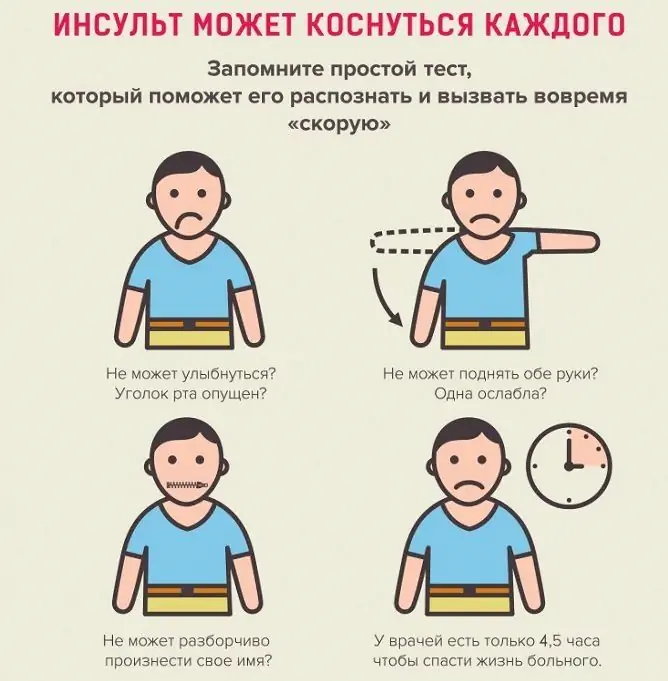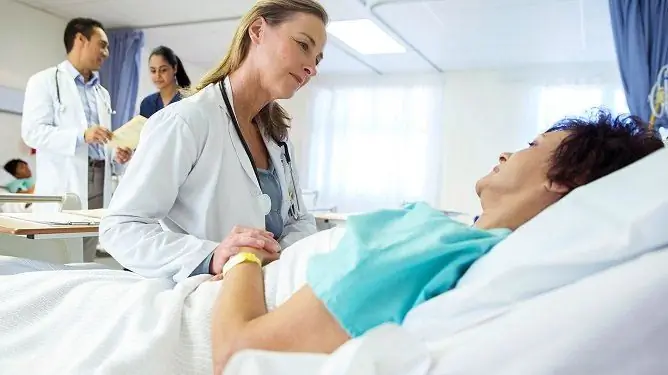- Author Rachel Wainwright [email protected].
- Public 2023-12-15 07:39.
- Last modified 2025-11-02 20:14.
Clubfoot in children
The content of the article:
- Causes and risk factors
- Forms of the disease
- Disease stages
- Symptoms
- Diagnostics
- Treatment of clubfoot in children
- Possible complications and consequences
- Forecast
- Prevention
Clubfoot in children is a complex disorder of the anatomy and functions of the musculoskeletal system, which consists in deformity of the foot, limitation of articular mobility, as well as in the wrong position of the bones of the talo-navicular joint. In this case, the foot deviates from the longitudinal axis of the lower leg inward. The disease in half of the cases is bilateral. The pathological process can involve muscles, bones, joints, blood vessels and nerves. More common in boys.

Clubfoot is a common pathology of the musculoskeletal system
Causes and risk factors
The causes of the pathology have not yet been reliably clarified. Presumably, most often, congenital clubfoot in children is caused by an abnormal position of the fetus in the uterus or oligohydramnios. In addition, the formation of clubfoot in children can be influenced by alcohol, drug and tobacco dependence of a pregnant woman, as well as genetic factors that contribute to disorders in the formation of the musculo-ligamentous apparatus at the prenatal stage of development, deficiency of nerve fibers, muscle underdevelopment, etc.
Acquired clubfoot in children can form due to wearing inappropriate shoes, muscle paralysis, polio, underdevelopment of bones, previous diseases of the legs, traumatic injuries of the lower extremities (ligaments, bones), burns of the feet, rickets, due to an increase in the load on the feet with increased growth and weight gain by a child.
The typical form of clubfoot in children develops against the background of a violation of the structure of ligaments, tendons and muscles. The atypical form of clubfoot can be caused by diseases of the central nervous system, as well as serious disorders of the musculoskeletal system.
Forms of the disease
Clubfoot in children is divided into congenital and acquired.
Depending on the involvement of the extremities, clubfoot in children is unilateral and bilateral.
There are two main forms:
- typical clubfoot;
- atypical clubfoot.
Depending on the severity of the course, there are three degrees of the typical form of the disease:
- varus contractures (I degree) - have a mild course and amenable to manual correction;
- soft tissue form (II degree) - characterized by the inability to completely put the foot on the floor. Resistance of soft tissues is noted during manual correction of the defect;
- bone form (III degree) - is relatively rare and is characterized by pronounced deformity of the foot due to the pathology of bone and soft tissues, conservative treatment cannot be treated.
Clinical and etiological classification of clubfoot:
- idiopathic - a decrease in the talus, equinus, violation of the relationship between the front and back of the feet, shortening of the gastrocnemius muscle, disorders of the joints of the foot, vascular pathology of the anterior parts of the leg;
- postural, or positional - the talus and calcaneus are unchanged, the articular surfaces are developed normally, but are in a state of subluxation;
- congenital clubfoot in combination with congenital myo- and neuropathy - secondary deformity of the foot caused by developmental disorders of other parts of the musculoskeletal system (for example, congenital dislocation of the hip);
- syndromological - it combines congenital clubfoot, combined with congenital myo- and neuropathy with anomalies in the development of other organs.
Disease stages
There are three stages of clubfoot in children:
- Light - minor changes in the child's musculoskeletal system are characteristic, while the movements in the ankle joint are completely preserved.
- Moderate (medium) - the pathology is more pronounced, movements in the ankle joint are limited, but with the right treatment, the defect must be corrected.
- Severe - severe deformation of the ankle joint, pathology requires surgical intervention.
Symptoms
Symptoms of the congenital form of clubfoot can be detected in the fetus even at the stage of intrauterine development (in the second and third trimesters of pregnancy) during ultrasound examination. The main signs of pathology are:
- torsion - twisting of the shin bones outward;
- varus - the feet are shifted inward relative to the midline;
- equinus ("horse foot") - the foot is bent at the ankle;
- adduction - full turn of the foot with the sole up.

Clubfoot in children is easily identified visually
Additional symptoms include:
- transverse inflection of the sole (the so-called inflection), defined by the Adams groove;
- limitation of mobility of the ankle joint;
- the size of the foot is less than normal;
- inward displacement of the heel axis;
- the heel is lifted up, the toe is lowered.
The acquired form of clubfoot in children, as a rule, begins to manifest itself at the age of 2-3 years with the following signs:
- incorrect positioning of the foot, noticeable by the way the child leaves marks - the mark from one leg is turned to the side;
- hallux valgus (the big toe deviates inward);
- a disturbed gait, the so-called bear gait, when one leg (with one-sided clubfoot) or both (with two-sided) make raking movements;
- restriction of movement in the ankle joint;
- turning the knees inward.
The symptoms of clubfoot in children are most noticeable during sleep, when the muscles relax.
Diagnostics
Preliminary diagnosis of congenital clubfoot is carried out at the stage of intrauterine development during an ultrasound screening study. The diagnosis is confirmed by an objective examination of the newborn. Congenital clubfoot is found before the baby can walk.

Congenital clubfoot is diagnosed at the stage of intrauterine development
Acquired clubfoot develops after the child begins to walk, so it is found at a later age. Parents' attention is drawn to the way the child puts his feet when walking. To make a diagnosis, anamnesis is collected and interviews with parents, an objective examination and palpation of the foot. To confirm clubfoot, additional studies may be required - ultrasound and computed tomography. Radiography of the feet in this case is not very informative, since the cartilaginous tissue that makes up small bones in children is not clearly visible on radiographic images.
Treatment of clubfoot in children
The choice of treatment regimen for clubfoot in children depends on the type, degree and stage of the disease. Treatment of a congenital form of clubfoot begins from the first week of a child's life, acquired - immediately after diagnosis.
The initial degrees and early stages of clubfoot in children are corrected by conservative methods, the main of which are massage, foot fixation, and physiotherapy exercises.

Mild clubfoot is corrected with massage, exercise therapy, foot fixation
Massage for clubfoot in children with a mild degree of the disease can be the main method of treatment, in more severe cases it is actively used as an auxiliary one, as it improves blood circulation in the foot, contributes to the development of muscles, ligaments, and joints.
Fixation of the foot and lower leg is carried out by two main methods:
- traditional plastering;
- plastering according to the Ponseti method (stage-by-stage plastering from the sole to the knee joint, which helps to correct the position of the foot in different planes).
Before applying the plaster, a course of foot massage is recommended for 1-2 weeks. The cast is changed every two weeks so as not to interfere with the normal growth of the leg. For the best effect, plastering is alternated with paraffin applications. The duration of therapy depends on the degree of the disease and varies from several months to several years. After removing the plaster, monitoring of the condition of the legs using X-ray is shown.
To lengthen the Achilles tendon, sometimes closed Achilles are used, which is performed in children under two years of age. After the manipulation, plaster fixation is shown for a period of about 3 weeks. The total duration of treatment can be several months, depending on the severity of the pathological process.

Plaster cast is a traditional treatment for clubfoot in children.
After completing the course of fixing the feet, it is shown wearing semi-rigid boots with straight dense protectors (braces), with which the foot is fixed in the desired position, which prevents the recurrence of the disease.
Surgical intervention is carried out at a severe stage of the disease, as well as in the absence of a positive effect from conservative therapy.
Possible complications and consequences
It is recommended to correct the congenital form of clubfoot in children during the first months of a child's life (optimally - up to 4 months), otherwise the pathology is aggravated, and subsequently may require radical treatment methods. Neglected forms of clubfoot in children can cause scoliosis, flat feet, muscle atrophy, dysfunction of the ankle and knee joints and other dysfunctions of the lower extremities up to the loss of the ability to walk.
Forecast
With early diagnosis and timely treatment, the prognosis of the disease is favorable. Severe clubfoot can lead to patient disability.
Prevention
To prevent the development of congenital clubfoot in children, it is recommended:
- monitoring the condition of the fetus during pregnancy;
- rational nutrition of a pregnant woman;
- giving up bad habits during pregnancy.
Prevention of acquired clubfoot in children includes:
- observation of the child's gait, timely referral to a doctor when suspicious symptoms appear;
- sufficient, but not exhausting physical activity (swimming, cycling, slow running, etc.);
- avoiding long walks with a child who has recently learned to walk;
- selection of quality children's shoes;
- inclusion in the child's diet of foods rich in calcium;
- walking barefoot on sand, pebbles, massage rugs;
- correction of excess weight in a child.
YouTube video related to the article:

Anna Aksenova Medical journalist About the author
Education: 2004-2007 "First Kiev Medical College" specialty "Laboratory Diagnostics".
The information is generalized and provided for informational purposes only. At the first sign of illness, see your doctor. Self-medication is hazardous to health!






